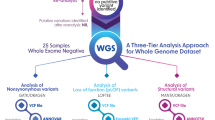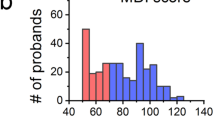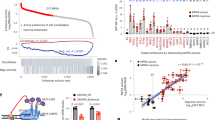Abstract
Clinically significant cardiovascular malformations (CVMs) occur in 5–8 per 1000 live births. Recurrent copy number variations (CNVs) are among the known causes of syndromic CVMs, accounting for an important fraction of cases. We hypothesized that many additional rare CNVs also cause CVMs and can be detected in patients with CVMs plus extracardiac anomalies (ECAs). Through a genome-wide survey of 203 subjects with CVMs and ECAs, we identified 55 CNVs >50 kb in length that were not present in children without known cardiovascular defects (n=872). Sixteen unique CNVs overlapping these variants were found in an independent CVM plus ECA cohort (n=511), which were not observed in 2011 controls. The study identified 12/16 (75%) novel loci including non-recurrent de novo 16q24.3 loss (4/714) and de novo 2q31.3q32.1 loss encompassing PPP1R1C and PDE1A (2/714). The study also narrowed critical intervals in three well-recognized genomic disorders of CVM, such as the cat-eye syndrome region on 22q11.1, 8p23.1 loss encompassing GATA4 and SOX7 and 17p13.3-p13.2 loss. An analysis of protein-interaction databases shows that the rare inherited and de novo CNVs detected in the combined cohort are enriched for genes encoding proteins that are direct or indirect partners of proteins known to be required for normal cardiac development. Our findings implicate rare variants such as 16q24.3 loss and 2q31.3-q32.1 loss, and delineate regions within previously reported structural variants known to cause CVMs.
Similar content being viewed by others
Log in or create a free account to read this content
Gain free access to this article, as well as selected content from this journal and more on nature.com
or
References
Hoffman JI, Kaplan S, Liberthson RR : Prevalence of congenital heart disease. Am Heart J 2004; 147: 425–439.
Ferencz C, Boughman JA : Congenital heart disease in adolescents and adults. Teratology, genetics, and recurrence risks. Cardiol Clin 1993; 11: 557–567.
Ferencz C, Boughman JA, Neill CA, Brenner JI, Perry LW : Congenital cardiovascular malformations: questions on inheritance. Baltimore-Washington Infant Study Group. J Am Coll Cardiol 1989; 14: 756–763.
Botto LD, Correa A, Erickson JD : Racial and temporal variations in the prevalence of heart defects. Pediatrics 2001; 107: E32.
Calzolari E, Garani G, Cocchi G et al. Congenital heart defects: 15 years of experience of the Emilia-Romagna Registry (Italy). Eur J Epidemiol 2003; 18: 773–780.
Pradat P, Francannet C, Harris JA, Robert E : The epidemiology of cardiovascular defects, part I: a study based on data from three large registries of congenital malformations. Pediatr Cardiol 2003; 24: 195–221.
Bernier PL, Stefanescu A, Samoukovic G, Tchervenkov CI : The challenge of congenital heart disease worldwide: epidemiologic and demographic facts. Semin Thorac Cardiovasc Surg Pediatr Card Surg Annu 2010; 13: 26–34.
Hoffman JI, Kaplan S : The incidence of congenital heart disease. J Am Coll Cardiol 2002; 39: 1890–1900.
Hartman RJ, Rasmussen SA, Botto LD et al. The contribution of chromosomal abnormalities to congenital heart defects: a population-based study. Pediatr Cardiol 2011; 32: 1147–1157.
Richards AA, Garg V : Genetics of congenital heart disease. Curr Cardiol Rev 2010; 6: 91–97.
van der Bom T, Zomer AC, Zwinderman AH, Meijboom FJ, Bouma BJ, Mulder BJ : The changing epidemiology of congenital heart disease. Nat Rev Cardiol 2011; 8: 50–60.
Lupski JR : Genomic disorders ten years on. Genome Med 2009; 1: 42.
Thienpont B, Mertens L, de Ravel T et al. Submicroscopic chromosomal imbalances detected by array-CGH are a frequent cause of congenital heart defects in selected patients. Eur Heart J 2007; 28: 2778–2784.
Moerman P, Goddeeris P, Lauwerijns J, Van der Hauwaert LG : Cardiovascular malformations in DiGeorge syndrome (congenital absence of hypoplasia of the thymus). Br Heart J 1980; 44: 452–459.
Fontaine JL, Vernant P, Graveleau D, Lagardere B, Elchardus JF : [Elfin facies, mental retardation and cardiovascular anomalies (Williams and Beuren’s syndrome). Report of two cases]. Ann Pediatr (Paris) 1976; 23: 37–42.
Edelman EA, Girirajan S, Finucane B et al. Gender, genotype, and phenotype differences in Smith-Magenis syndrome: a meta-analysis of 105 cases. Clin Genet 2007; 71: 540–550.
Shaw-Smith C, Pittman AM, Willatt L et al. Microdeletion encompassing MAPT at chromosome 17q21.3 is associated with developmental delay and learning disability. Nat Genet 2006; 38: 1032–1037.
Ballif BC, Theisen A, Rosenfeld JA et al. Identification of a recurrent microdeletion at 17q23.1q23.2 flanked by segmental duplications associated with heart defects and limb abnormalities. Am J Hum Genet 2010; 86: 454–461.
Lindsay EA, Vitelli F, Su H et al. Tbx1 haploinsufficieny in the DiGeorge syndrome region causes aortic arch defects in mice. Nature 2001; 410: 97–101.
Curran ME, Atkinson DL, Ewart AK, Morris CA, Leppert MF, Keating MT : The elastin gene is disrupted by a translocation associated with supravalvular aortic stenosis. Cell 1993; 73: 159–168.
Houle D : How should we explain variation in the genetic variance of traits? Genetica 1998; 102–103: 241–253.
Greenway SC, Pereira AC, Lin JC et al. De novo copy number variants identify new genes and loci in isolated sporadic tetralogy of Fallot. Nat Genet 2009; 41: 931–935.
Belmont JW : Heart patterning and congenital defects; in Moody SA, (ed): Principles of Developmental Biology. Amsterdam: Elsevier, 2007, pp 698–720.
Botto LD, Lin AE, Riehle-Colarusso T, Malik S, Correa A : Seeking causes: classifying and evaluating congenital heart defects in etiologic studies. Birth Defects Res A Clin Mol Teratol 2007; 79: 714–727.
Boone PM, Bacino CA, Shaw CA et al. Detection of clinically relevant exonic copy-number changes by array CGH. Hum Mutat 2010; 31: 1326–1342.
Shao L, Shaw CA, Lu XY et al. Identification of chromosome abnormalities in subtelomeric regions by microarray analysis: a study of 5380 cases. Am J Med Genet A 2008; 146A: 2242–2251.
Ou Z, Kang SH, Shaw CA et al. Bacterial artificial chromosome-emulation oligonucleotide arrays for targeted clinical array-comparative genomic hybridization analyses. Genet Med 2008; 10: 278–289.
Kuang SQ, Guo DC, Prakash SK et al. Recurrent chromosome 16p13.1 duplications are a risk factor for aortic dissections. PLoS Genet 2011; 7: e1002118.
Huang N, Lee I, Marcotte EM, Hurles ME : Characterising and predicting haploinsufficiency in the human genome. PLoS Genet 2010; 6: e1001154.
Heilstedt HA, Ballif BC, Howard LA et al. Physical map of 1p36, placement of breakpoints in monosomy 1p36, and clinical characterization of the syndrome. Am J Hum Genet 2003; 72: 1200–1212.
Mosca AL, Pinson L, Andrieux J et al. Refining the critical region for congenital diaphragmatic hernia on chromosome 15q26 from the study of four fetuses. Prenat Diagn 2011; 31: 912–914.
Davidsson J, Collin A, Bjorkhem G, Soller M : Array based characterization of a terminal deletion involving chromosome subband 15q26.2: an emerging syndrome associated with growth retardation, cardiac defects and developmental delay. BMC Med Genet 2008; 9: 2.
Klaassens M, Galjaard RJ, Scott DA et al. Prenatal detection and outcome of congenital diaphragmatic hernia (CDH) associated with deletion of chromosome 15q26: two patients and review of the literature. Am J Med Genet A 2007; 143A: 2204–2212.
Slavotinek AM, Moshrefi A, Davis R et al. Array comparative genomic hybridization in patients with congenital diaphragmatic hernia: mapping of four CDH-critical regions and sequencing of candidate genes at 15q26.1-15q26.2. Eur J Hum Genet 2006; 14: 999–1008.
Tumer Z, Harboe TL, Blennow E, Kalscheuer VM, Tommerup N, Brondum-Nielsen K : Molecular cytogenetic characterization of ring chromosome 15 in three unrelated patients. Am J Med Genet A 2004; 130A: 340–344.
Zollino M, Murdolo M, Marangi G et al. On the nosology and pathogenesis of Wolf-Hirschhorn syndrome: genotype-phenotype correlation analysis of 80 patients and literature review. Am J Med Genet C Semin Med Genet 2008; 148C: 257–269.
Mainardi PC, Perfumo C, Cali A et al. Clinical and molecular characterisation of 80 patients with 5p deletion: genotype-phenotype correlation. J Med Genet 2001; 38: 151–158.
Cardoso C, Leventer RJ, Ward HL et al. Refinement of a 400-kb critical region allows genotypic differentiation between isolated lissencephaly, Miller-Dieker syndrome, and other phenotypes secondary to deletions of 17p13.3. Am J Hum Genet 2003; 72: 918–930.
Oda T, Elkahloun AG, Pike BL et al. Mutations in the human Jagged1 gene are responsible for Alagille syndrome. Nat Genet 1997; 16: 235–242.
Reiner O, Carrozzo R, Shen Y et al. Isolation of a Miller-Dieker lissencephaly gene containing G protein beta-subunit-like repeats. Nature 1993; 364: 717–721.
Thienpont B, Zhang L, Postma AV et al. Haploinsufficiency of TAB2 causes congenital heart defects in humans. Am J Hum Genet 2010; 86: 839–849.
Willemsen MH, Fernandez BA, Bacino CA et al. Identification of ANKRD11 and ZNF778 as candidate genes for autism and variable cognitive impairment in the novel 16q24.3 microdeletion syndrome. Eur J Hum Genet 2010; 18: 429–435.
Sirmaci A, Spiliopoulos M, Brancati F et al. Mutations in ANKRD11 cause KBG syndrome, characterized by intellectual disability, skeletal malformations, and macrodontia. Am J Hum Genet 2011; 89: 289–294.
Brancati F, D'Avanzo MG, Digilio MC et al. KBG syndrome in a cohort of Italian patients. Am J Med Genet A 2004; 131: 144–149.
Devriendt K, Holvoet M, Fryns JP : Further delineation of the KBG syndrome. Genet Couns 1998; 9: 191–194.
Rivera-Vega MR, Leyva Juarez N, Cuevas-Covarrubias SA, Kofman-Alfaro SH : Congenital heart defect and conductive hypoacusia in a patient with the KBG syndrome. Clin Genet 1996; 50: 278–279.
Isrie M, Hendriks Y, Gielissen N et al. Haploinsufficiency of ANKRD11 causes mild cognitive impairment, short stature and minor dysmorphisms. Eur J Hum Genet 2012; 20: 131–133.
Rosias PR, Sijstermans JM, Theunissen PM et al. Phenotypic variability of the cat eye syndrome. Case report and review of the literature. Genet Couns 2001; 12: 273–282.
Riazi AM, Van Arsdell G, Buchwald M : Transgenic expression of CECR1 adenosine deaminase in mice results in abnormal development of heart and kidney. Transgenic Res 2005; 14: 333–336.
Michibata H, Yanaka N, Kanoh Y, Okumura K, Omori K : Human Ca2+/calmodulin-dependent phosphodiesterase PDE1A: novel splice variants, their specific expression, genomic organization, and chromosomal localization. Biochim Biophys Acta 2001; 1517: 278–287.
Miller CL, Oikawa M, Cai Y et al. Role of Ca2+/calmodulin-stimulated cyclic nucleotide phosphodiesterase 1 in mediating cardiomyocyte hypertrophy. Circ Res 2009; 105: 956–964.
Swayne LA, Mezghrani A, Varrault A et al. The NALCN ion channel is activated by M3 muscarinic receptors in a pancreatic beta-cell line. EMBO Rep 2009; 10: 873–880.
Song K, Backs J, McAnally J et al. The transcriptional coactivator CAMTA2 stimulates cardiac growth by opposing class II histone deacetylases. Cell 2006; 125: 453–466.
Zhang C, Basta T, Klymkowsky MW : SOX7 and SOX18 are essential for cardiogenesis in Xenopus. Dev Dyn 2005; 234: 878–891.
Hazra TK, Kow YW, Hatahet Z et al. Identification and characterization of a novel human DNA glycosylase for repair of cytosine-derived lesions. J Biol Chem 2002; 277: 30417–30420.
Bamforth SD, Braganca J, Farthing CR et al. Cited2 controls left-right patterning and heart development through a Nodal-Pitx2c pathway. Nat Genet 2004; 36: 1189–1196.
Iascone M, Ciccone R, Galletti L et al. Identification of de novo mutations and rare variants in hypoplastic left heart syndrome. Clin Genet 2012; 81: 542–554.
Richards AA, Santos LJ, Nichols HA et al. Cryptic chromosomal abnormalities identified in children with congenital heart disease. Pediatr Res 2008; 64: 358–363.
Acknowledgements
We thank the families for participating in the study. We thank Zhilian Xia for providing technical support. The support for this work was provided by the National Institutes of Health (RO1-HL091771) to JWB, Doris Duke Charitable Foundation and Gillson Longenbaugh Foundation to SRL and March of Dimes support (MOD: 1-FY10-401) to SRL and SMW. Pawel Stankiewicz was supported in part by Grant R13-0005-04/2008 from the Polish Ministry of Science and Higher Education.
Author information
Authors and Affiliations
Corresponding author
Ethics declarations
Competing interests
Multiple authors are based in the Department of Molecular and Human Genetics at Baylor College of Medicine, which derives revenue from molecular diagnostic testing (Medical Genetics Laboratories).
Additional information
Supplementary Information accompanies the paper on European Journal of Human Genetics website
Supplementary information
Rights and permissions
About this article
Cite this article
Lalani, S., Shaw, C., Wang, X. et al. Rare DNA copy number variants in cardiovascular malformations with extracardiac abnormalities. Eur J Hum Genet 21, 173–181 (2013). https://doi.org/10.1038/ejhg.2012.155
Received:
Revised:
Accepted:
Published:
Issue date:
DOI: https://doi.org/10.1038/ejhg.2012.155
Keywords
This article is cited by
-
Clinical exome sequencing efficacy and phenotypic expansions involving anomalous pulmonary venous return
European Journal of Human Genetics (2023)
-
Copy number variant analysis for syndromic congenital heart disease in the Chinese population
Human Genomics (2022)
-
The importance of copy number variation in congenital heart disease
npj Genomic Medicine (2016)
-
Rare copy number variants and congenital heart defects in the 22q11.2 deletion syndrome
Human Genetics (2016)
-
De novo deletions and duplications of 17q25.3 cause susceptibility to cardiovascular malformations
Orphanet Journal of Rare Diseases (2015)



